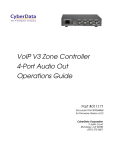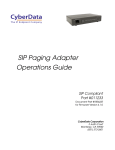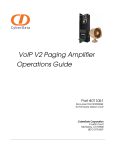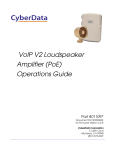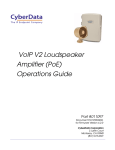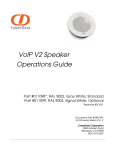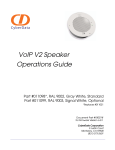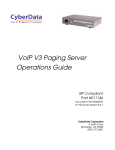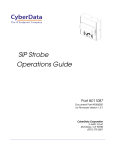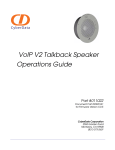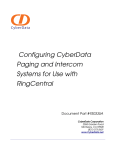Download CyberData 011171 Product specifications
Transcript
The IP Endpoint Company VoIP V3 Zone Controller 4-Port Audio Out Operations Guide Part #011171 Document Part #930446E for Firmware Version 6.0.2 CyberData Corporation 3 Justin Court Monterey, CA 93940 (831) 373-2601 Operations Guide 930446E SiP Compliant 011171 COPYRIGHT NOTICE: © 2012, CyberData Corporation, ALL RIGHTS RESERVED. This manual and related materials are the copyrighted property of CyberData Corporation. No part of this manual or related materials may be reproduced or transmitted, in any form or by any means (except for internal use by licensed customers), without prior express written permission of CyberData Corporation. This manual, and the products, software, firmware, and/or hardware described in this manual are the property of CyberData Corporation, provided under the terms of an agreement between CyberData Corporation and recipient of this manual, and their use is subject to that agreement and its terms. DISCLAIMER: Except as expressly and specifically stated in a written agreement executed by CyberData Corporation, CyberData Corporation makes no representation or warranty, express or implied, including any warranty or merchantability or fitness for any purpose, with respect to this manual or the products, software, firmware, and/or hardware described herein, and CyberData Corporation assumes no liability for damages or claims resulting from any use of this manual or such products, software, firmware, and/or hardware. CyberData Corporation reserves the right to make changes, without notice, to this manual and to any such product, software, firmware, and/or hardware. OPEN SOURCE STATEMENT: Certain software components included in CyberData products are subject to the GNU General Public License (GPL) and Lesser GNU General Public License (LGPL) “open source” or “free software” licenses. Some of this Open Source Software may be owned by third parties. Open Source Software is not subject to the terms and conditions of the CyberData COPYRIGHT NOTICE or software licenses. Your right to copy, modify, and distribute any Open Source Software is determined by the terms of the GPL, LGPL, or third party, according to who licenses that software. Software or firmware developed by Cyberdata that is unrelated to Open Source Software is copyrighted by CyberData, subject to the terms of CyberData licenses, and may not be copied, modified, reverse-engineered, or otherwise altered without explicit written permission from CyberData Corporation. TRADEMARK NOTICE: CyberData Corporation and the CyberData Corporation logos are trademarks of CyberData Corporation. Other product names, trademarks, and service marks may be the trademarks or registered trademarks of their respective owners. Technical Support The IP Endpoint Company The fastest way to get technical support for your VoIP product is to submit a VoIP Technical Support form at the following website: http://www.cyberdata.net/support/contactsupportvoip.html Phone: (831) 373-2601, Ext. 333 Email: [email protected] Fax: (831) 373-4193 Company and product information is at www.cyberdata.net. Operations Guide 930446E CyberData Corporation Revision History Revision 930446E, which corresponds to firmware version 6.0.2, was released on October 16, 2012 and has the following changes: • Updates Table 2-2, "Factory Default Settings". Operations Guide 930446E CyberData Corporation i Contents Chapter 1 Product Overview 1 1.1 How to Identify this Product ................................................................................................................1 1.2 Product features .....................................................................................................................................2 1.3 Supported ................................................................................................................................................2 1.4 Product Specifications ...........................................................................................................................2 Chapter 2 Implementing the VoIP V3 Zone Controller 3 2.1 Parts List ..................................................................................................................................................3 2.2 Typical Installation .................................................................................................................................4 2.3 Setting up the VoIP Zone Controller ...................................................................................................5 2.3.1 Cables Used for Connecting to Legacy Analog Amplifiers ..................................................5 2.3.2 Connect to the Power Source ....................................................................................................5 Poe ................................................................................................................................................5 Non-Poe .......................................................................................................................................5 Chassis Ground ..........................................................................................................................5 2.3.3 Connect to the Network ............................................................................................................6 2.3.4 Confirm that the VoIP Zone Controller is Up and Running ................................................7 Confirm Power on, Network Connectivity, and Connection Speed ..................................7 2.3.5 Restore the Factory Default Settings as Required .................................................................8 2.4 Configuring the VoIP Zone Controller ...............................................................................................9 2.4.1 Gather the Required Configuration Information ..................................................................9 Static or DHCP Addressing? ...................................................................................................9 Username and Password for Configuration GUI .................................................................9 SIP Settings .................................................................................................................................9 2.4.2 VoIP Zone Controller Web Page Navigation .........................................................................10 2.4.3 Log in to the Configuration GUI ............................................................................................ 11 2.4.4 Configure the Device Parameters ...........................................................................................14 2.4.5 Configure the Network Parameters ...................................................................................... 16 2.4.6 Configure the SIP Parameters ................................................................................................. 18 Point-to-Point Configuration ................................................................................................. 21 2.4.7 Configure the Multicast Parameters ....................................................................................... 22 Assigning Priority .................................................................................................................... 23 2.4.8 Configure the Night Ringer Parameters ................................................................................ 24 2.4.9 Configure the Zone Parameters .............................................................................................. 26 Operating the VoIP Zone Controller ..................................................................................... 27 2.4.10 Configure the Audio Parameters .......................................................................................... 28 User-created Audio Files ......................................................................................................... 31 2.4.11 Configure the Event Parameters ...........................................................................................33 Example Packets for Events ....................................................................................................35 2.4.12 Configure the Autoprovisioning Parameters ...................................................................... 38 Autoprovisioning ..................................................................................................................... 40 2.5 Upgrading the Firmware ................................................................................................................... 43 Upgrade the Firmware ............................................................................................................ 44 Mounting the VoIP Zone Controller 45 A.1 Mount the VoIP Zone Controller .....................................................................................................45 A.1.1 Mounting Components ........................................................................................................... 45 A.1.2 Mounting Procedure ................................................................................................................ 46 Appendix A Setting Up a TFTP Server Operations Guide 930446E 47 CyberData Corporation ii A.1 Set up a TFTP Server .......................................................................................................................... 47 A.1.1 In a LINUX Environment ........................................................................................................ 47 A.1.2 In a Windows Environment ................................................................................................... 47 Appendix B Troubleshooting/Technical Support 48 B.1 Frequently Asked Questions (FAQ) .................................................................................................. 48 B.1.1 Documentation .......................................................................................................................... 48 B.2 Contact Information ............................................................................................................................ 49 B.3 Warranty ............................................................................................................................................... 50 B.3.1 Warranty & RMA Returns within the United States ........................................................... 50 B.3.2 Warranty & RMA Returns Outside of the United States .................................................... 50 B.3.3 Spare in the Air Policy .............................................................................................................50 B.3.4 Return and Restocking Policy ................................................................................................. 51 B.3.5 Warranty and RMA Returns Page .......................................................................................... 51 Index Operations Guide 52 930446E CyberData Corporation 1 1 Product Overview The CyberData VoIP V3 Zone Controller with Audio-Out enables access to existing paging speakers through a VoIP phone system. The interface is designed to use a standard paging amplifier with audio inputs and supports paging up to 15 zone groups from a VoIP phone. The VoIP Zone Controller is a PoE-enabled, single SIP-endpoint, enabling user-defined paging zones through RCA line level output connections to legacy analog amplifiers to existing legacy analog speakers. SIP compliant IP-PBX's can now interface with existing legacy analog paging speaker installations. 1.1 How to Identify this Product To identify the VoIP Zone Controller, look for a model number label similar to the one shown in Figure 1-1. The model number on the label should be 011171. Figure 1-1. Model Number Label WWW.CYBERDATA.NET CONTROLLER,V3 VoIP ZONE,4-PORT AUDIO OUT, RoHS COMPLIANT 011171B / 021065B 171000001 Model number Operations Guide 930446E CyberData Corporation Product Overview 2 Product features 1.2 Product features • Delayed paging • Night Ringer • Compatible with more IP/PBX servers • SIP RFC 3261 compatible • PoE 802.3af enabled (Power-over-ethernet) • Dual-speed ethernet 10/100 Mbps • 4 Paging zones • 15 Paging zone groups • Page all • Web-based configuration • Web-based firmware upgradeable • Connector for external power supply • Small footprint 1.3 Supported • HTTP Web-based configuration • Provides an intuitive GUI for easy system configuration and verification of speaker operations. • DHCP Client • TFTP Client • Audio Codec • G.711 U-law • DTMF detection 1.4 Product Specifications Specifications Operations Guide Regulatory Compliance FCC Class A, UL 60950, CE Power Requirement PoE or 48V DC Connection Speed 10/100 Mbps Protocol SIP compliant Part Number 011171 Dimensions 6.11”L x 4.05”W x 1.15” H Weight 1.2 pounds 930446E CyberData Corporation 3 2 Implementing the VoIP V3 Zone Controller The topics in this chapter provide information on setting up, configuring, and using the VoIP Zone Controller. 2.1 Parts List The packaging for the VoIP Zone Controller includes the parts in this illustration. Table 2-1. Parts List Quanti ty Operations Guide Part Name 1 VoIP V3 Zone Controller 1 Installation Quick Reference Guide 1 Mounting Kit 930446E Illustration CyberData Corporation Implementing the VoIP V3 Zone Controller 4 Typical Installation 2.2 Typical Installation Figure 2-1 illustrates how the VoIP Zone Controller is normally installed as part of a paging system. Figure 2-1. Typical Installation VoIP V3 Zone Controller 4-Port Audio Out Generic PoE Switch 1 2 3 4 5 6 IP Phone IP PBX Server Analog Amplifiers Paging Speakers Operations Guide 930446E CyberData Corporation Implementing the VoIP V3 Zone Controller 5 Setting up the VoIP Zone Controller 2.3 Setting up the VoIP Zone Controller Before you set up the VoIP Zone Controller, be sure that you have received all the parts described in Section 2.1, "Parts List". 2.3.1 Cables Used for Connecting to Legacy Analog Amplifiers The VoIP Zone Controller connects to zones through RCA line level output connections to legacy analog amplifiers to existing legacy analog speakers. 2.3.2 Connect to the Power Source Figure 2-2. Connecting to the Power Source PoE To set up the VoIP Zone Controller, connect the device to your network: Poe • For PoE, plug one end of an 802.3af Ethernet cable into the VoIP Zone Controller Ethernet port. Plug the other end of the Ethernet cable into your network. See the figure on the left. Non PoE (with 48 VDC power supply) Non-Poe • For Non-PoE, connect the VoIP Zone Controller to a 48VDC power supply. See the figure on the left. Chassis Ground Chassis Ground • If required, connect the earth grounding wire to the Chassis Ground on the back of the unit. See the figure on the left. Chassis Ground Operations Guide 930446E CyberData Corporation Implementing the VoIP V3 Zone Controller 6 Setting up the VoIP Zone Controller 2.3.3 Connect to the Network Plug one end of a standard Ethernet cable into the VoIP Zone Controller Ethernet port. Plug the other end into your network. Figure 2-3. Connecting to the Network Operations Guide 930446E CyberData Corporation Implementing the VoIP V3 Zone Controller 7 Setting up the VoIP Zone Controller 2.3.4 Confirm that the VoIP Zone Controller is Up and Running The indicator LEDs on the front of the VoIP Zone Controller verify the unit’s operations. Figure 2-4. VoIP Zone Controller Indicator LEDs Front View with LEDs Link (YELLOW LED) Activity (GREEN LED) Status (GREEN LED) Audio Activity (GREEN LED) Power Status (BLUE LED) 2.3.4.1 Confirm Power on, Network Connectivity, and Connection Speed When you plug in the Ethernet cable or power supply: • The round, BLUE Power Status LED on the front of the VoIP Zone Controller comes on indicating that the power is on. • The square, YELLOW Link LED above the Ethernet port indicates that the network connection has been established. The Link LED changes color to confirm the auto-negotiated connection speed: • This LED is YELLOW at 10 Mbps. • This LED is ORANGE at 100 Mbps. • The square, GREEN Activity LED above the Ethernet port blinks when there is network activity. • The round, GREEN Status LED comes on after the device is booted and initialized. This LED blinks when the unit is operational. • The square, GREEN Audio Activity LEDs turn on solid when a Zone is being paged. Operations Guide 930446E CyberData Corporation Implementing the VoIP V3 Zone Controller 8 Setting up the VoIP Zone Controller 2.3.5 Restore the Factory Default Settings as Required The VoIP Zone Controller is delivered with factory set default values for the following parameters. Use the RTFM switch (see Figure 2-5) on the back of the unit to restore these parameters to the factory default settings. Figure 2-5. RTFM Switch Back View with RTFM Switch To restore the VoIP Zone Controller’s factory default settings: 1. Use a paper clip to press and hold the RTFM switch while all of the indicator LEDs turn off. See the picture on the right. 2. Continue to press the RTFM switch until after the indicator LEDs turn back on. 3. Release the RTFM switch. All of the VoIP Zone Controller settings will be restored to the factory default settings. Paper clip RTFM switch 4. You will hear the "Restoring defaults..." audio message play through all ports before the device reboots. Note When you perform the RTFM procedure in Figure 2-5, the factory default settings are restored. The default parameters for access are shown in Table 2-2. Table 2-2. Factory Default Settings Parameter Factory Default Setting IP Addressing DHCP IP Addressa 10.10.10.10 Web Access Username admin Web Access Password admin Subnet Maska 255.0.0.0 Default Gatewaya 10.0.0.1 a. Default if there is not a DHCP server present. Operations Guide 930446E CyberData Corporation Implementing the VoIP V3 Zone Controller 9 Configuring the VoIP Zone Controller 2.4 Configuring the VoIP Zone Controller Use this section to configure the VoIP Zone Controller. 2.4.1 Gather the Required Configuration Information Have the following information available before you configure the VoIP Zone Controller. 2.4.1.1 Static or DHCP Addressing? Know whether your system uses static or dynamic (DHCP) IP addressing. If it uses static addressing, you also need to know the values to assign to the following VoIP Zone Controller parameters: • IP Address • Subnet Mask • Default Gateway 2.4.1.2 Username and Password for Configuration GUI Determine the Username and Password that will replace the defaults after you initially log in to the configuration GUI. • The Username is case-sensitive, and must be from four to 25 alphanumeric characters long. • The Password is case-sensitive, and must be from four to 20 alphanumeric characters long. 2.4.1.3 SIP Settings To configure the SIP parameters, determine whether you want to register the VoIP Zone Controller. If you do, determine the number of minutes the registration lease remains valid, and whether you want to automatically unregister when you reboot. To configure the SIP parameters, you also need to determine the values for these parameters: • SIP Server IP Address • Remote and Local SIP Port Numbers • SIP User ID, and Authenticate ID and Password for this User ID Operations Guide 930446E CyberData Corporation Implementing the VoIP V3 Zone Controller 10 Configuring the VoIP Zone Controller 2.4.2 VoIP Zone Controller Web Page Navigation Table 2-3 shows the navigation buttons that you will see on every VoIP Zone Controller web page. Table 2-3. V3 Paging Amplifier Web Page Navigation Web Page Item Description Link to the Home page. Link to the Device Configuration page. Link to the Networking page. Link to go to the SIP Configuration page. Link to the Multicast Configuration page. Link to go to the Nightringer page. Link to go to the Zone Configuration page. Link to the Audio Configuration page. Link to the Event Configuration page. Link to the Autoprovisioning Configuration page. Link to the Update Firmware page. Operations Guide 930446E CyberData Corporation Implementing the VoIP V3 Zone Controller 11 Configuring the VoIP Zone Controller 2.4.3 Log in to the Configuration GUI 1. Open your browser to the VoIP Zone Controller IP address. Note If the network does not have access to a DHCP server, the device will default to an IP address of 10.10.10.10. Note Make sure that the PC is on the same IP network as the VoIP Zone Controller. Note You may also download CyberData’s VoIP Discovery Utility program which allows you to easily find and configure the default web address of the CyberData VoIP products. CyberData’s VoIP Discovery Utility program is available at the following website address: http://www.cyberdata.net/support/voip/discovery_utility.html The unit ships in DHCP mode. To get to the Home page, use the discovery utility to scan for the device on the network and open your browser from there. Note To work with the VoIP Zone Controller configuration after the initial configuration, log in using the IP address you assign to the device. Section 2.4.5, "Configure the Network Parameters" provides instructions for entering the IP address. 2. When prompted, use the following default Username and Password to open the configuration Home page: Username: admin Password: admin Change the To change the default Web access Username and Password: Default Username 1. Enter the new Username from four to 25 alphanumeric characters in the Change Username and Password field. The Username is case-sensitive. 2. Enter the new Password from four to 20 alphanumeric characters in the Change Password field. The Password is case-sensitive. 3. Enter the new password again in the Re-enter New Password field. Click Save Settings. Operations Guide 930446E CyberData Corporation Implementing the VoIP V3 Zone Controller 12 Configuring the VoIP Zone Controller Figure 2-6. Home Page Operations Guide 930446E CyberData Corporation Implementing the VoIP V3 Zone Controller 13 Configuring the VoIP Zone Controller 4. On the Home Page, review the setup details and navigation buttons described in Table 2-4. Table 2-4. Home Page Overview Web Page Item Description Device Settings Device Name Shows the device name (25 character limit). Change Username Type in this field to change the username (25 character limit). Change Password Type in this field to change the password (19 character limit). Re-enter Password Type the password again in this field to confirm the new password (19 character limit). Current Settings Serial Number Shows the device serial number. Mac Address Shows the device Mac address. Firmware Version Shows the current firmware version. IP Addressing Shows the current IP addressing setting (DHCP or Static). IP Address Shows the current IP address. Subnet Mask Shows the current subnet mask address. Default Gateway Shows the current default gateway address. DNS Server 1 Shows the current DNS Server 1 address. DNS Server 2 Shows the current DNS Server 2 address. SIP Mode is Shows the current status of the SIP Mode. Event Reporting is Shows the current status of the Event Reporting. Nightring is Shows the current status of the Nightringer. Click the Save button to save your configuration settings. Note: You need to reboot for changes to take effect. Click on the Reboot button to reboot the system. At this point you can: • Review the VoIP Zone Controller’s Current Settings. Use the RTFM switch to restore the factory default settings. See Section 2.3.5, "Restore the Factory Default Settings as Required". • Configure the network parameters. Click the Networking button and refer to Section 2.4.5, "Configure the Network Parameters" for instructions. • Configure the SIP parameters. Click SIP Config and see Section 2.4.6, "Configure the SIP Parameters". • Configure the Zone parameters. Click Zone Config and see Section 2.4.9, "Configure the Zone Parameters" for instructions. Note Operations Guide Click the Upgrade Firmware button any time you need to upload new versions of the firmware. Refer to Section 2.5, "Upgrading the Firmware" for instructions. 930446E CyberData Corporation Implementing the VoIP V3 Zone Controller 14 Configuring the VoIP Zone Controller 2.4.4 Configure the Device Parameters 1. Click the Device Configuration button to open the Device Configuration page. See Figure 2-7. Figure 2-7. Device Configuration Page Operations Guide 930446E CyberData Corporation Implementing the VoIP V3 Zone Controller 15 Configuring the VoIP Zone Controller 2. On the Device Configuration page, you may enter values for the parameters indicated in Table 2-5. Table 2-5. Device Configuration Parameters Web Page Item Description Miscellaneous Settings Beep on Initialization When selected, you will hear a beep when the speaker initializes. Beep on Page When selected, you will hear a beep when a page is sent from the device. Test Audio Port 1 through Port 4 Select the desired port(s) for the audio test. Click on the Test Audio button to do an audio test. When the Test Audio button is pressed, you will hear a voice message for testing the device audio quality and volume. Click the Save button to save your configuration settings. Note: You need to reboot for changes to take effect. Click on the Reboot button to reboot the system. 3. After changing the parameters, click the Save button. Operations Guide 930446E CyberData Corporation Implementing the VoIP V3 Zone Controller 16 Configuring the VoIP Zone Controller 2.4.5 Configure the Network Parameters Configuring the network parameters enables your network to recognize the VoIP Zone Controller and communicate with it. Click Network Setup on the Home page to open the Network Configuration page. Figure 2-8. Network Setup Page Operations Guide 930446E CyberData Corporation Implementing the VoIP V3 Zone Controller 17 Configuring the VoIP Zone Controller On the Network Setup page, enter values for the parameters indicated in Table 2-6. Table 2-6. Network Configuration Parameters Web Page Item Description Stored Network Settings Shows the settings stored in non-volatile memory. IP Addressing Select either DHCP IP Addressing or Static IP Addressing by marking the appropriate radio button. If you select Static, configure the remaining parameters indicated in Table 2-6. If you select DHCP, go to Step 3. IP Address Enter the Static IP address. Subnet Mask Enter the Subnet Mask address. Default Gateway Enter the Default Gateway address. DNS Server 1 Enter the DNS Server 1 address. DNS Server 2 Enter the DNS Server 2 address. Current Network Settings Shows the current network settings. IP Address Shows the current Static IP address. Subnet Mask Shows the current Subnet Mask address. Default Gateway Shows the current Default Gateway address. DNS Server 1 Shows the current DNS Server 1 address. DNS Server 2 Shows the current DNS Server 2 address. Click the Save button to save your configuration settings. Note: You need to reboot for changes to take effect. Click on the Reboot button to reboot the system. On this page: 1. Specify whether you use Static or DHCP IP Addressing by marking the appropriate radio button. Then, if you select Static, go to Step 2. 2. For Static IP Addressing, also enter values for the following parameters: • The VoIP Zone Controller’s IP Address: The VoIP Zone Controller is delivered with a factory default IP address. Change the default address to the correct IP address for your system. • The Subnet Mask. • The Default Gateway. 3. Click Save when you are finished. 4. Click Reboot for the new settings to take effect. Operations Guide 930446E CyberData Corporation Implementing the VoIP V3 Zone Controller 18 Configuring the VoIP Zone Controller 2.4.6 Configure the SIP Parameters The SIP parameters enable the VoIP Zone Controller to contact and register with the SIP server. On the Home page, click SIP Config to open the SIP Configuration page. Figure 2-9. SIP Configuration Page Operations Guide 930446E CyberData Corporation Implementing the VoIP V3 Zone Controller 19 Configuring the VoIP Zone Controller 5. On the SIP Setup page, enter values for the parameters indicated in Table 2-7. Table 2-7. SIP Configuration Parameters Web Page Item Description SIP Settings SIP Server Type the SIP server represented as either a numeric IP address in dotted decimal notation or the fully qualified host name (255 character limit [FQDN]). Remote SIP Port Type the Remote SIP Port number (default 5060) (8 character limit). Local SIP Port Type the Local SIP Port number (default 5060) (8 character limit). Outbound Proxy Type the Outbound Proxy as either a numeric IP address in dotted decimal notation or the fully qualified host name (255 character limit [FQDN]). Outbound Proxy Port Type the Outbound Proxy Port number (8 character limit). SIP User ID Type the SIP User ID (up to 64 alphanumeric characters). Authenticate ID Type the Authenticate ID (up to 64 alphanumeric characters). Authenticate Password Type the Authenticate Password (up to 64 alphanumeric characters). Register with a SIP Server Enable or disable SIP Registration. For information about Point-to-Point Configuration, see Section 2.4.6.1, "Point-to-Point Configuration". Re-registration Interval (in seconds) Type the SIP Registration lease time in seconds (default is 60 minutes) (8 character limit). Re-registration Interval (in seconds) Unregister on Reboot When selected, on boot, the device will first register with a SIP server with a expiration delay of 0 seconds. This has the effect of unregistering any current devices on this extension. Buffer SIP Calls When this is enabled, SIP calls to the device will be stored in memory and will play when either the call is terminated or the buffer is full. The receive buffer is 2MB in size and this is equal to about four minutes of ulaw encoded audio. Click the Save button to save your configuration settings. Note: You need to reboot for changes to take effect. Click on the Reboot button to reboot the system. 1. Enter the IP address of the SIP Server. 2. Enter the port numbers used for SIP signaling: a. Remote SIP Port b. Local SIP Port Operations Guide 930446E CyberData Corporation Implementing the VoIP V3 Zone Controller 20 Configuring the VoIP Zone Controller 3. Enter the SIP registration parameters: a. SIP User ID b. Authenticate ID c. Authenticate Password 4. For SIP Registration, designate whether you want the device to register with your SIP server. 5. At Unregister on Reboot: a. Select Yes to automatically unregister the VoIP Zone Controller when you reboot it. b. Select No to keep the VoIP Zone Controller registered when you reboot it. 6. In the Register Expiration field, enter the number of seconds the VoIP Zone Controller registration lease remains valid with the SIP Server. The VoIP Zone Controller automatically reregisters with the SIP server before the lease expiration timeout. 7. Click Save. 8. Click Reboot for the new settings to take effect. Operations Guide 930446E CyberData Corporation Implementing the VoIP V3 Zone Controller 21 Configuring the VoIP Zone Controller 2.4.6.1 Point-to-Point Configuration When the board is set to not register with a SIP server, it's possible to set the device to dial out to a single endpoint. To do this, do the following: 1. On the SIP Configuration page (Figure 2-10), make sure that the Register with a SIP Server parameter is not selected. 2. Type the IP address of the remote device that you want to contact into the Dial out Extension field Note The delayed DTMF functionality is available in the Point-to-Point Mode. Note Establishing point-to-point SiP calls may not work with all phones. Figure 2-10. SIP Configuration Page Set to Point-to-Point Mode Device is set to NOT register with a SIP server Operations Guide 930446E CyberData Corporation Implementing the VoIP V3 Zone Controller 22 Configuring the VoIP Zone Controller 2.4.7 Configure the Multicast Parameters The Multicast Configuration page allows the Zone Controller to join up to one paging zone for receiving an emergency ulaw/alaw encoded RTP audio stream. A paging zone can consist of one or many CyberData multicast group-enabled products. There is no limit to how many devices can be in a given paging zone. A multicast group is defined by a multicast address and port number. Each multicast group is assigned a priority, allowing simultaneously arriving pages to be serviced based on importance. Multicast groups are compatible with IGMP through version three. The Zone Controller will preempt all other audio when receiving a multicast page because it is considered emergency priority. 1. Click on the Multicast Configuration button to open the Multicast Configuration page. See Figure 2-11. Figure 2-11. Multicast Configuration Page Operations Guide 930446E CyberData Corporation Implementing the VoIP V3 Zone Controller 23 Configuring the VoIP Zone Controller 2. On the Multicast Configuration page, enter values for the parameters indicated in Table 2-8. Table 2-8. Multicast Configuration Parameters Web Page Item Description Enable Multicast Operation Enables or disables multicast operation. Device Settings Priority Emergency The priority is fixed as "Emergency" and it is the only group that is available on this device. Address Enter the multicast IP Address for this multicast group (15 character limit). Port (range can be from 2000 to 65535) Enter the port number for this multicast group (5 character limit). Note: The multicast ports have to be even values. The webpage will enforce this restriction. Multicast Group Name Assign a descriptive name for this multicast group (25 character limit). Click the Save button to save your configuration settings. Note: You need to reboot for changes to take effect. Click on the Reboot button to reboot the system. 3. After changing the parameters, click on the Save button. 2.4.7.1 Assigning Priority When playing a multicast stream, all other audio will be preempted as the multicast group is considered an emergency group. Note Ringtones and Nightringtones Operations Guide SIP calls, multicast streams, ring tones, ringback tones, and nightring tones are all prioritized. Ringtones all play at the same priority level. This means that it is possible to have a nightring tone and a normal ringtone playing at the same time. 930446E CyberData Corporation Implementing the VoIP V3 Zone Controller 24 Configuring the VoIP Zone Controller 2.4.8 Configure the Night Ringer Parameters Caution Nightringer requires SIP Registration. Nightringer cannot be used in peer to peer mode. GENERAL ALERT 1. Click on the Nightringer button to open the Nightringer Configuration page. See Figure 2-12. Figure 2-12. Nightringer Configuration Setup Operations Guide 930446E CyberData Corporation Implementing the VoIP V3 Zone Controller 25 Configuring the VoIP Zone Controller 2. On the Nightringer Configuration page, enter values for the parameters indicated in Table 2-9. Table 2-9. Nightringer Configuration Parameters Web Page Item Description Enable Nightringer When the nightringer is enabled, the unit will attempt to register a second extension with the SIP server. Any calls made to this extension will play a ringtone. Nightringer Settings SIP Server Type the SIP server represented as either a numeric IP address in dotted decimal notation. Remote SIP Port Type the Remote SIP Port number (default 5060) (8 character limit). Local SIP Port Type the Local SIP Port number (default 5061) (8 character limit). Note: This value cannot be the same as the Local SIP Port found on the SIP Configuration Page. User ID Type the User ID (up to 64 alphanumeric characters). Authenticate ID Type the Authenticate ID (up to 64 alphanumeric characters). Authenticate Password Type the Authenticate Password (up to 64 alphanumeric characters). Re-registration Interval (in seconds) Type the SIP Registration lease time in seconds (default is 60 minutes) (8 character limit). Re-registration Interval (in seconds) Play audio on ports When selected, a user-defined audio file is sent to the specified port(s) when the night ringer is activated. Click the Save button to save your configuration settings. Note: You need to reboot for changes to take effect. Click on the Reboot button to reboot the system. 3. After changing the parameters, click on the Save button. 4. Click Reboot for the new settings to take effect. Operations Guide 930446E CyberData Corporation Implementing the VoIP V3 Zone Controller 26 Configuring the VoIP Zone Controller 2.4.9 Configure the Zone Parameters • Each audio output jack on the VoIP Zone Controller represents a Zone. • A Group is comprised of a combination of one or more Zones. • You will need to plug any Zones that are used on the VoIP Zone Controller into an analog amplifier. Any speakers attached to the amplifier will be present in the Zone. 1. Click on the Zone Config button to open the Zone Configuration page. See Figure 2-13. Figure 2-13. Zone Configuration Setup Operations Guide 930446E CyberData Corporation Implementing the VoIP V3 Zone Controller 27 Configuring the VoIP Zone Controller 2. On the Zone Configuration page, enter values for the parameters indicated in Table 2-10. Table 2-10. Zone Configuration Parameters Web Page Item Description Zones Bypass DTMF When selected, the ports in Zone 00 will be paged without waiting for DTMF entry. Port 1 through Port 4 Checkboxes Check the box for the port(s) that comprise the zone. Click the Save button to save your configuration settings. Note: You need to reboot for changes to take effect. Click on the Reboot button to reboot the system. 3. After changing the parameters, click on the Save button. 4. Click Reboot for the new settings to take effect. 2.4.9.1 Operating the VoIP Zone Controller To operate the VoIP Zone Controller: 1. Call to make a page. The VoIP Zone Controller will generate a tone over the phone. 2. When you hear this tone, enter the two-digit code for the group that you want to page. Note If the Bypass DTMF setting is enabled, go to Step 4. 3. If the zone is valid, the VoIP Zone Controller will play the user-defined "good zone" sound. Go to Step 4. Note If the zone is invalid, the VoIP Zone Controller will play the user-defined "bad zone" sound. Repeat Step 2. 4. When you hear the "good zone" tone, you can begin speaking. Operations Guide 930446E CyberData Corporation Implementing the VoIP V3 Zone Controller 28 Configuring the VoIP Zone Controller 2.4.10 Configure the Audio Parameters Click the Audio Config button to open the Audio Configuration page. See Figure 2-14. The Audio Configuration page is used to add custom audio to the board. User uploaded audio will take precedence over the audio files shipped with the VoIP Zone Controller. Figure 2-14. Audio Configuration Page Operations Guide 930446E CyberData Corporation Implementing the VoIP V3 Zone Controller 29 Configuring the VoIP Zone Controller Figure 2-15. Audio Configuration Page Note Operations Guide To test an audio file, first select the ports (located at the bottom of the Audio Configuration Page) that you want to play the audio file to, and then press the Play button for the desired audio file. 930446E CyberData Corporation Implementing the VoIP V3 Zone Controller 30 Configuring the VoIP Zone Controller On the Audio Configuration page, enter values for the parameters indicated in Table 2-11. Note Each entry on the Audio Configuration page replaces one of the stock audio files on the board. When the input box displays the word default, the VoIP Zone Controller is using the stock audio file. If that file is replaced with a user file, it will display the uploaded filename. Table 2-11. Audio Configuration Parameters Web Page Item Description Audio Files 0-9 The name of the audio configuration option is the same as the spoken audio that plays on the board (24 character limit). '0' corresponds to the spoken word “zero.” '1' corresponds to the spoken word “one.” '2' corresponds to the spoken word “two.” '3' corresponds to the spoken word “three.” '4' corresponds to the spoken word “four.” '5' corresponds to the spoken word “five.” '6' corresponds to the spoken word “six.” '7' corresponds to the spoken word “seven.” '8' corresponds to the spoken word “eight.” '9' corresponds to the spoken word “nine.” Dot Corresponds to the spoken word “dot.” (24 character limit). Audiotest Corresponds to the message “This is the CyberData IP speaker test message...” (24 character limit). Pagetone Corresponds to a simple tone that is unused by default (24 character limit). Invalid Zone Corresponds to the message “Invalid Zone” (24 character limit). Your IP Address is Corresponds to the message “Your IP address is...” (24 character limit). Rebooting Corresponds to the spoken word “Rebooting” (24 character limit). Restoring default Corresponds to the message “Restoring default” (24 character limit). Night Ring Specifies the ringtone for nightring. By default this parameter uses the same audio file that is selected for the Ring Tone parameter. Ports to play test audio Port 1 through Port 4 Select the desired port(s) for the audio test. The Browse button will allow you to navigate to and select an audio file. The Play button will play that audio file. The Delete button will delete any user uploaded audio and restore the stock audio file. The Save button will download a new user audio file to the board once you've selected the file by using the Browse button. The Save button will delete any pre-existing user-uploaded audio files. Operations Guide 930446E CyberData Corporation Implementing the VoIP V3 Zone Controller 31 Configuring the VoIP Zone Controller 2.4.10.1 User-created Audio Files User created audio files should be saved in the following format: RIFF (little-endian) data, WAVE audio, Microsoft PCM, 16 bit, mono 8000 Hz You can use the free utility Audacity to convert audio files into this format. See Figure 2-16 through Figure 2-18. Figure 2-16. Audacity 1 Figure 2-17. Audacity 2 Operations Guide 930446E CyberData Corporation Implementing the VoIP V3 Zone Controller 32 Configuring the VoIP Zone Controller When you export an audio file with Audacity, save the output as: • WAV (Microsoft) signed 16 bit PCM. Figure 2-18. WAV (Microsoft) signed 16 bit PCM WAV (Microsoft) signed 16 bit PCM Operations Guide 930446E CyberData Corporation Implementing the VoIP V3 Zone Controller 33 Configuring the VoIP Zone Controller 2.4.11 Configure the Event Parameters Click the Event Config button to open the Event Configuration page (Figure 2-19). The Event Configuration page specifies a remote server that can be used to receive HTTP POST events when actions take place on the board. Figure 2-19. Event Configuration Page Operations Guide 930446E CyberData Corporation Implementing the VoIP V3 Zone Controller 34 Configuring the VoIP Zone Controller Table 2-12 shows the web page items on the Event Configuration page. Table 2-12. Event Configuration Web Page Item Description Enable Event Generation When selected, Event Generation is enabled. Remote Event Server Remote Event Server IP Type the Remote Event Server IP address. (64 character limit) Remote Event Server Port Type the Remote Event Server port number. (8 character limit) Remote Event Server URL Type the Remote Event Server URL. (127 character limit) Events Enable Call Active Events When selected, Call Active Events are enabled. Enable Call Terminated Events When selected, Call Terminated Events are enabled. Enable Night Ring Events When selected, there is a notification when the unit receives a night ring. Enable Power On Events When selected, Power On Events are enabled. Enable 60 Second Heartbeat Events When selected, 60 Second Heartbeat Events are enabled. Click the Save button to save your configuration settings. Note: You need to reboot for changes to take effect. Click on the Test Event button to test an event. Click on the Reboot button to reboot the system. Operations Guide 930446E CyberData Corporation Implementing the VoIP V3 Zone Controller 35 Configuring the VoIP Zone Controller 2.4.11.1 Example Packets for Events The server and port are used to point to the listening server and the 'Remote Event Server URL' is the destination URL (typically the script running on the remote server that's used to parse and process the POST events). Note The XML is URL-encoded before transmission so the following examples are not completely accurate. Here are example packets for every event: POST xmlparse_engine HTTP/1.1 Host: 10.0.3.79 User-Agent: CyberData/1.0.0 Content-Length: 197 Content-Type: application/x-www-form-urlencoded <?xml version="1.0" encoding="ISO-8859-1"?> <cyberdata NAME='CyberData VoIP Device' MAC='0020f70015b6'> <event>POWERON</event> </cyberdata> POST xmlparse_engine HTTP/1.1 Host: 10.0.3.79 User-Agent: CyberData/1.0.0 Content-Length: 199 Content-Type: application/x-www-form-urlencoded <?xml version="1.0" encoding="ISO-8859-1"?> <cyberdata NAME='CyberData VoIP Device' MAC='0020f70015b6'> <event>HEARTBEAT</event> </cyberdata> POST xmlparse_engine HTTP/1.1 Host: 10.0.3.79 User-Agent: CyberData/1.0.0 Content-Length: 196 Content-Type: application/x-www-form-urlencoded <?xml version="1.0" encoding="ISO-8859-1"?> <cyberdata NAME='CyberData VoIP Device' MAC='0020f70015b6'> <event>BUTTON</event> </cyberdata> POST xmlparse_engine HTTP/1.1 Host: 10.0.3.79 User-Agent: CyberData/1.0.0 Content-Length: 201 Content-Type: application/x-www-form-urlencoded <?xml version="1.0" encoding="ISO-8859-1"?> <cyberdata NAME='CyberData VoIP Device' MAC='0020f70015b6'> <event>CALL_ACTIVE</event> </cyberdata> POST xmlparse_engine HTTP/1.1 Operations Guide 930446E CyberData Corporation Implementing the VoIP V3 Zone Controller 36 Configuring the VoIP Zone Controller Host: 10.0.3.79 User-Agent: CyberData/1.0.0 Content-Length: 205 Content-Type: application/x-www-form-urlencoded <?xml version="1.0" encoding="ISO-8859-1"?> <cyberdata NAME='CyberData VoIP Device' MAC='0020f70015b6'> <event>CALL_TERMINATED</event> </cyberdata> POST xmlparse_engine HTTP/1.1 Host: 10.0.3.79 User-Agent: CyberData/1.0.0 Content-Length: 197 Content-Type: application/x-www-form-urlencoded <?xml version="1.0" encoding="ISO-8859-1"?> <cyberdata NAME='CyberData VoIP Device' MAC='0020f70015b6'> <event>RINGING</event> </cyberdata> POST xmlparse_engine HTTP/1.1 Host: 10.0.3.79 User-Agent: CyberData/1.0.0 Content-Length: 234 Content-Type: application/x-www-form-urlencoded <?xml version="1.0" encoding="ISO-8859-1"?> <cyberdata NAME='CyberData VoIP Device' MAC='0020f70015b6'> <event>MULTICAST_START</event> <index>8</index> </cyberdata> POST xmlparse_engine HTTP/1.1 Host: 10.0.3.79 User-Agent: CyberData/1.0.0 Content-Length: 233 Content-Type: application/x-www-form-urlencoded <?xml version="1.0" encoding="ISO-8859-1"?> <cyberdata NAME='CyberData VoIP Device' MAC='0020f70015b6'> <event>MULTICAST_STOP</event> <index>8</index> </cyberdata> POST xmlparse_engine HTTP/1.1 Host: 10.0.3.79 User-Agent: CyberData/1.0.0 Content-Length: 234 Content-Type: application/x-www-form-urlencoded <?xml version="1.0" encoding="ISO-8859-1"?> <cyberdata NAME='CyberData VoIP Device' MAC='0020f70015b6'> <event>RELAY_ACTIVATED</event> </cyberdata> POST xmlparse_engine HTTP/1.1 Operations Guide 930446E CyberData Corporation Implementing the VoIP V3 Zone Controller 37 Configuring the VoIP Zone Controller Host: 10.0.3.79 User-Agent: CyberData/1.0.0 Content-Length: 234 Content-Type: application/x-www-form-urlencoded <?xml version="1.0" encoding="ISO-8859-1"?> <cyberdata NAME='CyberData VoIP Device' MAC='0020f70015b6'> <event>RELAY_DEACTIVATED</event> </cyberdata> POST xmlparse_engine HTTP/1.1 Host: 10.0.3.79 User-Agent: CyberData/1.0.0 Content-Length: 234 Content-Type: application/x-www-form-urlencoded <?xml version="1.0" encoding="ISO-8859-1"?> <cyberdata NAME='CyberData VoIP Device' MAC='0020f70015b6'> <event>NIGHTRINGING</event> </cyberdata> Operations Guide 930446E CyberData Corporation Implementing the VoIP V3 Zone Controller 38 Configuring the VoIP Zone Controller 2.4.12 Configure the Autoprovisioning Parameters 1. Click the Autoprovisioning button to open the Autoprovisioning Configuration page. See Figure 2-20. Figure 2-20. Autoprovisioning Configuration Page Operations Guide 930446E CyberData Corporation Implementing the VoIP V3 Zone Controller 39 Configuring the VoIP Zone Controller 2. On the Autoprovisioning Configuration page, you may enter values for the parameters indicated in Table 2-13. Table 2-13. Autoprovisioning Configuration Parameters Web Page Item Description Autoprovisioning Enable Autoprovisioning See Section 2.4.12.1, "Autoprovisioning". Get Autoprovisioning from DHCP See Section 2.4.12.1, "Autoprovisioning". Autoprovisioning Server (IP Address) See Section 2.4.12.1, "Autoprovisioning" (15 character limit). Autoprovisioning Autoupdate (in minutes) Type the desired time (in minutes) that you want the Autoprovisioning feature to update (6 character limit). Autoprovisioning file name Displays the Autoprovisioning file name. Click the Save button to save your configuration settings. Note: You need to reboot for changes to take effect. Click on the Reboot button to reboot the system. 3. After changing the parameters, click the Save button. Operations Guide 930446E CyberData Corporation Implementing the VoIP V3 Zone Controller 40 Configuring the VoIP Zone Controller 2.4.12.1 Autoprovisioning Enable Autoprovisioning Option With autoprovisioning enabled, the board will get its configuration from a remote TFTP server on startup or periodically on a scheduled delay. Autoprovisioned values will override values stored in on-board memory and will be visible on the web page. The board gets its autoprovisioning information from an XML-formatted file hosted from a TFTP server. CyberData will provide a template for this XML file and the user can modify it for their own use. To use autoprovisioning, create a copy of the autoprovisioning template with the desired settings and name this file with the mac address of the device to configure (for example: 0020f7350058.config). Put this file into your TFTP server directory and manually set the TFTP server address on the board. It is not necessary to set every option found in the autoprovisioning template. As long as the XML is valid, the file can contain any subset. Options not autoprovisioned will default to the values stored in the on board memory. For example if you only wanted to modify the device name, the following would be a valid autoprovisioning file: <?xml version="1.0" encoding="utf-8" ?> <specific> <MiscSettings> <DeviceName>auto VoIP Zone Controller</DeviceName> </MiscSettings> </specific> Networking The board will only apply networking settings or firmware upgrades after a reboot. Get Autoprovisioning from DHCP When this option is checked, the device will automatically fetch its autoprovisioning server address from the DHCP server. The device will use the address specified in OPTION 150 (TFTP-servername) or OPTION 66. If both options are set, the device will use OPTION 150. Refer to the documentation of your DHCP server for setting up OPTION 150. Operations Guide 930446E CyberData Corporation Implementing the VoIP V3 Zone Controller 41 Configuring the VoIP Zone Controller To set up a Linux DHCPD server to serve autoprovisioning information (in this case using both option 66 and 150), here's an example dhcpd.conf: # dhcpd.conf # # Configuration file for ISC dhcpd (see 'man dhcpd.conf') # ddns-update-style ad-hoc; option option-150 code 150 = ip-address; subnet 10.0.0.0 netmask 255.0.0.0 { max-lease-time 120; default-lease-time 120; option routers option subnet-mask 10.0.0.1; 255.0.0.0; option domain-name option domain-name-servers "voiplab"; 10.0.0.1; option time-offset -8; option tftp-server-name "10.0.0.254"; option option-150 10.0.0.254; # Pacific Standard Time range 10.10.0.1 10.10.2.1;} Autoprovisioning Instead of using DHCP to provide the autoprovisioning tftp server address, you can specify an Server (IP Address) address manually. Autoprovisioning Autoupdate If Autoprovisioning is enabled and the Autoprovisioning Autoupdate value is something other than 0 minutes, a service is started on startup that will wait the configured number of minutes and then try to re-download its autoprovisioning file. It will compare its previously autoprovisioned file with this new file and if there are differences, it will reboot the board. Autoprovisioned An Autoprovisioned firmware upgrade only happens after a reboot, will take roughly three Firmware Upgrades minutes, and the web page will be unresponsive during this time. The 'FirmwareVersion' value in the xml file must match the version stored in the 'FirmwareFile'. For example: <FirmwareVersion>v6.0.0</FirmwareVersion> <FirmwareFile>600-uImage-zonecontroller</FirmwareFile> If these values are mismatched, the board can get stuck in a loop where it goes through the following sequence of actions: 1. The board downloads and writes a new firmware file. 2. After the next reboot, the board recognizes that the firmware version does not match. 3. The board downloads and writes the firmware file again. CyberData has timed a firmware upgrade at 140 seconds. Therefore, if you suspect the board is stuck in a loop, either remove or comment out the FirmwareVersion line in the XML file and let the board boot as it normally does. Operations Guide 930446E CyberData Corporation Implementing the VoIP V3 Zone Controller 42 Configuring the VoIP Zone Controller Note Autoprovisioned Audio Files For information about TFTP servers, see Appendix Section A.1, "Set up a TFTP Server". Audio files are stored in non-volatile memory and an autoprovisioned audio file will only have to be downloaded once for each device. Loading many audio files to the device from the web page could cause it to appear unresponsive. If this happens, wait until the transfer is complete and then refresh the page. The device uses the file name to determine when to download a new audio file. This means that if you used autoprovisioning to upload a file and then changed the contents of this file at the TFTP server, the device will not recognize that the file has changed (because the file name is the same). Since audio files are stored in non-volatile memory, if autoprovisioning is disabled after they have been loaded to the board, the audio file settings will not change. You can force a change to the audio files on the board by one of the following two ways: • Click Delete for each file that you want to restore to the factory default audio file on the Audio Configuration page. • Change the autoprovisioning file with the word “default” set as the file name. Operations Guide 930446E CyberData Corporation Implementing the VoIP V3 Zone Controller 43 Upgrading the Firmware 2.5 Upgrading the Firmware 1. Click the Update Firmware button to open the Upgrade Firmware page. See Figure 2-21. Figure 2-21. Upgrade Firmware Page Table 2-14 shows the web page items on the Upgrade Firmware page. Table 2-14. Upgrade Firmware Parameters Web Page Item Description File Upload Firmware Version Shows the current firmware version. Please specify a file Click the Browse button to navigate to the application firmware file that you want to upload. Click on the Submit button to automatically upload the selected firmware and reboot the system. Click on the Reboot button to reboot the system. Operations Guide 930446E CyberData Corporation Implementing the VoIP V3 Zone Controller 44 Upgrading the Firmware 2.5.0.1 Upgrade the Firmware To upload the firmware from your computer: 1. Retrieve the latest VoIP Zone Controller firmware from the VoIP V3 Paging Server Downloads page at: http://www.cyberdata.net/products/voip/legacyanalog/pagingzonev3/downloads.html 2. Unzip the VoIP Zone Controller version file. This file may contain the following: • Firmware file • Release notes 3. Log in to the VoIP Zone Controller home page as instructed in Section 2.4.3, "Log in to the Configuration GUI". 4. Click the Update Firmware button to open the Upgrade Firmware page. See Figure 2-21. 5. Click Browse, and then navigate to the location of the VoIP Zone Controller firmware file. 6. Click Submit. Note Operations Guide This starts the upload process. Once the VoIP Zone Controller has uploaded the file, the Uploading Firmware countdown page appears, indicating that the firmware is being written to flash. The VoIP Zone Controller will automatically reboot when the upload is complete. When the countdown finishes, the Upgrade Firmware page will refresh. The uploaded firmware filename should be displayed in the system configuration (indicating successful upload and reboot). 930446E CyberData Corporation 45 Appendix A: Mounting the VoIP Zone Controller A.1 Mount the VoIP Zone Controller A.1.1 Mounting Components Before you mount the VoIP Zone Controller, make sure that you have received all of the parts for each VoIP Zone Controller. Refer to Table A-1. Table A-1. Wall Mounting Components (Part of the Accessory Kit) Quantity Operations Guide Part Name Illustration 2 #6 x 1 1/2-inch Screws 2 #6 Plastic-Ribbed Anchors 930446E CyberData Corporation 46 Mount the VoIP Zone Controller A.1.2 Mounting Procedure To mount the VoIP Zone Controller: 1. On the mounting location, mark and then drill two 3/16-inch (0.1875-inch) holes 3.5 inches apart from and parallel to each other for the plastic-ribbed anchors and screws. See Figure A-1. 2. Insert the plastic-ribbed anchors into the prepared holes. See Figure A-1. 3. Install the #6 screws into the plastic-ribbed anchors and leave approximately 1/8-inch gap from the screw head to the wall. See Figure A-1. 4. Determine which sides of the VoIP Zone Controller will be facing up, and then slide the VoIP Zone Controller down over the screws to latch onto the screws. Figure A-1. Mounting Operations Guide 930446E CyberData Corporation 47 Appendix A: Setting Up a TFTP Server A.1 Set up a TFTP Server Autoprovisioning requires a TFTP server for hosting the configuration file. A.1.1 In a LINUX Environment To set up a TFTP server on LINUX: 1. Create a directory dedicated to the TFTP server, and move the files to be uploaded to that directory. 2. Run the following command where /tftpboot/ is the path to the directory you created in Step 1: the directory that contains the files to be uploaded. For example: in.tftpd -l -s /tftpboot/your_directory_name A.1.2 In a Windows Environment You can find several options online for setting up a Windows TFTP server. This example explains how to use the Solarwinds freeware TFTP server, which you can download at: http://www.cyberdata.net/support/voip/solarwinds.html To set up a TFTP server on Windows: 1. Install and start the software. 2. Select File/Configure/Security tab/Transmit Only. 3. Make a note of the default directory name, and then move the firmware files to be uploaded to that directory. Operations Guide 930446E CyberData Corporation 48 Appendix B: Troubleshooting/Technical Support B.1 Frequently Asked Questions (FAQ) Go to the following URL to see CyberData’s list of frequently asked questions: http://www.cyberdata.net/products/voip/legacyanalog/pagingzonev3/faqs.html B.1.1 Documentation The documentation for this product is released in an English language version only. You can download PDF copies of CyberData product documentation at: http://www.cyberdata.net/products/voip/legacyanalog/pagingzonev3/docs.html Operations Guide 930446E CyberData Corporation 49 Contact Information B.2 Contact Information Contact CyberData Corporation 3 Justin Court Monterey, CA 93940 USA www.CyberData.net Phone: 800-CYBERDATA (800-292-3732) Fax: 831-373-4193 Sales Sales 831-373-2601 Extension 334 Technical Support The fastest way to get technical support for your VoIP product is to submit a VoIP Technical Support form at the following website: http://www.cyberdata.net/support/contactsupportvoip.html Phone: (831) 373-2601, Ext. 333 Email: [email protected] Returned Materials Authorization To return the product, contact the Returned Materials Authorization (RMA) department: Phone: 831-373-2601, Extension 136 Email: [email protected] When returning a product to CyberData, an approved CyberData RMA number must be printed on the outside of the original shipping package. No product will be accepted for return without an approved RMA number. Send the product, in its original package, to the following address: CyberData Corporation 3 Justin Court Monterey, CA 93940 Attention: RMA "your RMA number" RMA Status Form If you need to inquire about the repair status of your product(s), please use the CyberData RMA Status form at the following web address: http://www.cyberdata.net/support/rmastatus.html Operations Guide 930446E CyberData Corporation 50 Warranty B.3 Warranty CyberData warrants its product against defects in material or workmanship for a period of two years from the date of purchase. Should the product fail within the warranty period, CyberData will repair or replace the product free of charge. This warranty includes all parts and labor. Should the product fail out-of-warranty, a flat rate repair charge of one half of the purchase price of the product will be assessed. Repairs that are in warranty but are damaged by improper modifications or abuse, will be charged at the out-of-warranty rate. Products shipped to CyberData, both in and out-of-warranty, are shipped at the expense of the customer. Shipping charges for repaired products shipped back to the customer by CyberData, will be paid by CyberData. CyberData shall not under any circumstances be liable to any person for any special, incidental, indirect or consequential damages, including without limitation, damages resulting from use or malfunction of the products, loss of profits or revenues or costs of replacement goods, even if CyberData is informed in advance of the possibility of such damages. B.3.1 Warranty & RMA Returns within the United States If service is required, you must contact CyberData Technical Support prior to returning any products to CyberData. Our Technical Support staff will determine if your product should be returned to us for further inspection. If Technical Support determines that your product needs to be returned to CyberData, an RMA number will be issued to you at this point. Your issued RMA number must be printed on the outside of the shipping box. No product will be accepted for return without an approved RMA number. The product in its original package should be sent to the following address: CyberData Corporation 3 Justin Court. Monterey, CA 93940 Attn: RMA "xxxxxx" B.3.2 Warranty & RMA Returns Outside of the United States If you purchased your equipment through an authorized international distributor or reseller, please contact them directly for product repairs. B.3.3 Spare in the Air Policy CyberData now offers a Spare in the Air no wait policy for warranty returns within the United States and Canada. More information about the Spare in the Air policy is available at the following web address: http://www.cyberdata.net/support/warranty/spareintheair.html Operations Guide 930446E CyberData Corporation 51 Warranty B.3.4 Return and Restocking Policy For our authorized distributors and resellers, please refer to your CyberData Service Agreement for information on our return guidelines and procedures. For End Users, please contact the company that you purchased your equipment from for their return policy. B.3.5 Warranty and RMA Returns Page The most recent warranty and RMA information is available at the CyberData Warranty and RMA Returns Page at the following web address: http://www.cyberdata.net/support/warranty/index.html Operations Guide 930446E CyberData Corporation 52 Index Numerics configuration page configurable parameters 13, 15, 17 connection speed 2 10 Mbps 7 100 Mbps 7 connection speeds 7 connections cables used 1, 5 contact information 49 contact information for CyberData 49 Current Network Settings 17 current network settings 17 current settings, reviewing 13 CyberData contact information 49 100 Mbps indicator LED 7 A act LED 7 activity LED 7 address, configuration login 11 addressing DHCP 9, 17 static 9, 17 admin username and password 11 amplifier connections cables used 1, 5 audio activity LED 7 audio configuration 28 night ring tone parameter 30 audio configuration page 28 authenticate ID and password for SIP server registration 20 autoprovisioning 40 autoprovisioned audio files 42 autoprovisioned firmware upgrades 41 autoprovisioning autoupdate 41 autoprovisioning enabled option 40 autoprovisioning from DHCP 40 autoprovisioning server (IP address) 41 networking 40 autoprovisioning configuration 38, 39 D default gateway 8 IP address 8 subnet mask 8 username and password 8 default gateway 8, 17 default gateway for static addressing 17 default login address 11 default password for configuration GUI 11 default settings, restoring 8 default username and password for configuration GUI 11 device configuration 14 device configuration parameters 39 the device configuration page 38 device configuration page 14 device configuration parameters 15 device configuration password changing for web configuration access 14 DHCP addressing 9, 17 DHCP IP addressing 17 dimensions 2 discovery utility program 11 DNS server 17 door sensor 30 B blue status LED 7 bypass DTMF 27 C cables used to connect the paging device to the legacy analog amplifiers 1, 5 changing the web access password 14 changing default username and password for configuration GUI 11 configurable parameters 13, 15, 17 configuration information 9 Operations Guide 930446E E enable night ring events 34 event configuration enable night ring events 34 CyberData Corporation 53 N expiration time for SIP server lease 19, 20, 25 navigation (web page) 10 navigation table 10 network configuration page 16 network parameters, configuring 16 network setup button 13, 16 network, connecting to 6 nightring tones 23 Nightringer 24 Nightringer in peer to peer mode (cannot be used) 24 nightringer settings 25 Nightringer, SIP registration required 24 F features 2 firmware where to get the latest firmware 44 firmware upgrade parameters 43 firmware, upgrade 13, 43 G Group 26 GUI username and password 11 O operating the zone controller 27 output connections 1, 5 I identifying your product 1 illustration of device mounting process 45 IP address 8, 17 SIP server 19 IP addressing 17 default IP addressing setting 8 P pages (lengthy) 23 paging LED 7 part number 2 parts list 3 password configuration GUI 9, 11 for SIP server login 19 restoring the default 8 SIP server authentication 20 pgroups configuration 13 point-to-point configuration 21 port local SIP 19 remote SIP 19 power connecting to 5 requirement 2 power status LED 7 priority assigning 23 product mounting 45 product overview 1 L lease, SIP server expiration time 19, 20, 25 lengthy pages 23 link LED 7 Linux, setting up a TFTP server on 47 local SIP port 19 log in address 11 logging in to configuration GUI 11 M MGROUP MGROUP Name 23 mounting procedure 46 mounting the device 45 multicast configuration 22 Multicast IP Address 23 R reboot 43 unregistering from SIP server during 20 registration and expiration, SIP server Operations Guide 930446E CyberData Corporation 54 T lease expiration 20 regulatory compliance 2 remote SIP port 19 required configuration for web access username and password 9, 11 resetting the IP address to the default 45, 48 restoring factory default settings 8 return and restocking policy 51 ringtones 23 lengthy pages 23 RMA returned materials authorization 49 RMA status 49 RTFM switch 8 tech support 49 technical support, contact information 49 TFTP server 47 U S sales 49 server SIP 13 TFTP 47 server address, SIP 19 service 49 SIP local SIP port 19 user ID 19 SIP configuration SIP Server 19 SIP configuration page 18 SIP configuration parameters 19 outbound proxy 19 registration and expiration, SIP server lease 19, 25 unregister on reboot 19 user ID, SIP 19 SIP registration 19 SIP remote SIP port 19 SIP server 19 password for login 19 unregister from 19 user ID for login 19 SIP server configuration 13 SIP server parameters, configuring 9 SIP settings 19 SIP setup button 13, 18 Spare in the Air Policy 50 specifications 2 speed of connection 2 static addressing 9, 17 static IP addressing 17 status LED 7 Stored Network Settings 17 subnet mask 8, 17 subnet mask static addressing 17 supported protocols 2 Operations Guide 930446E unregister from SIP server 20 upgrade firmware 13, 43 upgrade firmware button 13 user ID for SIP server login 19 user ID for SIP server registration 20 username changing for web configuration access 14 restoring the default 8 username for configuration GUI 9, 11 W warranty 50 warranty & RMA returns outside of the United States 50 warranty & RMA returns within the United States 50 warranty and RMA returns page 51 warranty policy at CyberData 50 web access password 8 web access username 8 web configuration log in address 11 web page navigation 10 web page navigation 10 weight 2 Windows, setting up a TFTP server on 47 Z Zone 26 zone controller configuration 9 zone controller operation 27 zone setup bypass DTMF 27 CyberData Corporation



























































